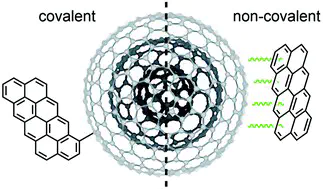
Abstract
An exhaustive and succinct minireview of the various reported approaches to the non-covalent surface modification of carbon nano-onions (CNOs). , Carbon nano-onions (CNOs) are concentric multi-layered fullerenes. Their shape, size and layer count depends on the method of preparation. Their low cytotoxicity allows for high applicability in the biomedical field, in particular, nanomedicine. However, an adequate dispersion of particles in aqueous media is required for the most effective use in this application. Given the hydrophobic nature of pristine CNOs, as is the case with most carbon nanomaterials, they show poor water solubility. Non-covalent functionalisation can be utilised to alter their dispersibility properties, without affecting the intrinsic properties of the sp 2 nanomaterial. The use of CNOs in the field of nanomedicine also requires consideration of drug release at the target site. As covalent bonds are inadequate for this purpose, attention is brought towards non-covalent interactions as a viable option for targeted release. This minireview outlines the different methods and approaches for non-covalent modifications of CNOs reported in the literature.